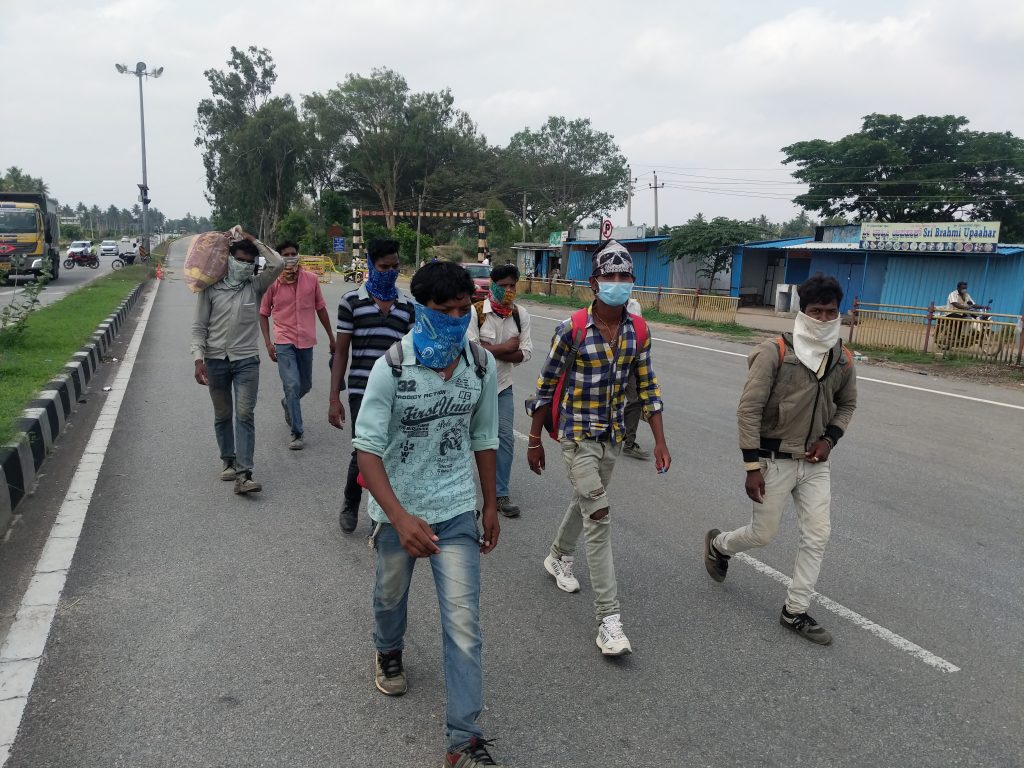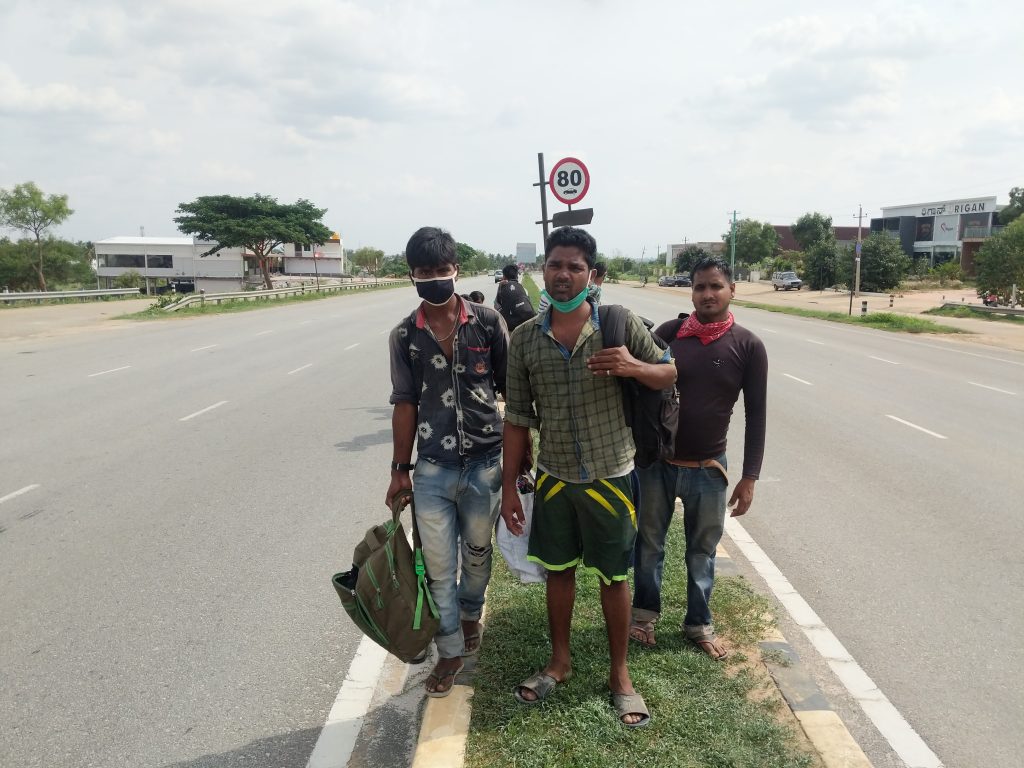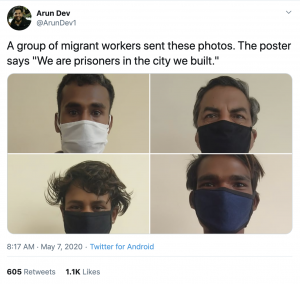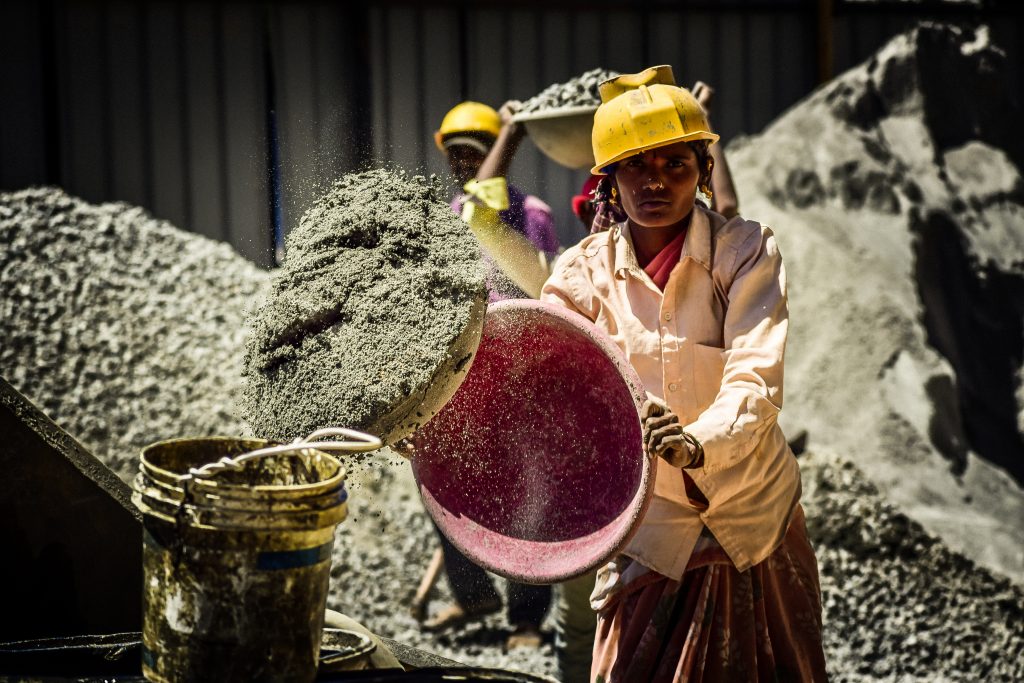Mumbai city (picture: Skye Vidur / CC BY-SA)
By Maitri Dore
“A house is not merely a place to take shelter from the rain or the cold or the sun,” said India’s first Prime Minister Jawaharlal Nehru. “It is, or should be, an enlargement of one’s personality, and if human welfare is our objective, this is bound up with the house.”
Nehru could not have foreseen what Covid-19 would wreak on how we inhabit space, but in a pandemic-tinted light, the statement takes on a new meaning. The virus – which, as of 12th May, has taken 2293 [i] lives in India – can safely be added to that list of items to shelter from. And home, now more than ever, is a safe haven.
Every year, thousands of people leave their families and homes in remote villages in India, and migrate to its glitzy cities for economic opportunities. As of the last census in 2011, the population of the country’s six largest metros was 48% [ii] migrant. To improve their lives, goes the narrative. When in fact, they’re improving the lives of the affluent. By night, they live in slums and on construction sites, by day they lay brick on brick to realise the palatial mansions, gated communities and cushy housing complexes, where the rich are now safely ensconced.

(picture: Mohit Rao)
When India’s lockdown – considered the world’s most stringent – was announced at four hours’ notice on 24th March, the urban elite seamlessly receded into the comfort of their homes. For countless migrant workers on the other hand, the loss of livelihood, shortage of food, and the tug of family back home, meant there was little reason to stay in the city. But with long-distance transport coming to a grinding halt, thousands sought other means to leave for their villages, in an exodus that is said to be the biggest since the partition of India in 1947.[iii] They walked and cycled, often carrying dependents, often for days, crossing state borders, travelling hundreds, even thousands of kilometres, attempting to brave hunger, exhaustion and police brutality. As of 10th May, there were at least 74 deaths caused by “Road or train accident due to walking/migration”.[iv] And those who could not leave were stuck in the city, often packed into small spaces or relief shelters, dependent on hand-outs.
Now, over five weeks on, special trains are being arranged to take stranded migrant labourers back home. But even as Indians abroad benefit from the world’s largest ever repatriation programme,[v] inhouse migrants are, in some cases, being charged their train fare home.[vi] Further, since many of them are construction workers, there has been pushback from builders, and consequent kow-towing by politicians. Karnataka State Chief Minister cancelled the proposed train service after a meeting with property developers, saying that in the interest of the economy, “unnecessary travel of the migrant workers ha[d] to be controlled” [vii]. And in Mumbai’s home state Maharashtra, construction work continues apace, with the state government having granted 150 private developers permission to continue with pre-existing work.[viii] Not to be easily appeased, developers are additionally trying to press the government into allowing new construction projects to commence as well. [ix]

(picture: Mohit Rao)
As of today, trains taking migrant labourers back home may have re-commenced in Karnataka, and on-site safety measures may be being provided in Maharashtra, but the bitter taste of irony remains: cities that are built on the backs of migrant labour have no qualms in closing their doors on them.
All of this highlights the acute power imbalance in how cities shaped. Their levers are controlled by an apathetic political class that is hand in glove with profit-seeking developers – part of the gang of “India’s heartless capitalists”.[x] These are cogs in the machinery of capitalism, whose insatiable drive, as David Harvey writes, is to “fix space”.[xi] In practical terms this means building immovable structures like housing, roads, factories and other physical infrastructure where capital can accumulate before springing to its next geographical target.

(source: Arun Dev’s twitter account)
As the latest example of the pandemic shows, the Right to the City, that entitles us “the freedom to make and remake our cities and ourselves”[xii] is far from universal, rendering even more urgent the clarion call “Cities for people, not for profit”.[xiii] This appeal by Brenner et al begs for politics to put human social needs above capitalist profit-making in the building of cities.[xiv]
A pipe dream though it may seem, when this is the case, India will be closer to the human welfare Nehru once spoke of. And labourers like Ravindra Ram in turn, may not have to point to a skyscraper they helped construct and ask, “We have built so many houses. Can’t we just go back to our home?”[xv]

(picture: Mdhuma / CC BY-SA
References
[i] Express Web Desk (2020) ‘Coronavirus India LIVE Updates’, The Indian Express, 12 May. Available from https://indianexpress.com/article/india/coronavirus-covid-19-india-live-latest-news-updates-total-corona-cases-in-india-global-recovered-deaths-6405248/. [12 May 2020]
[ii] Devulapalli, S. (2019) ‘Migrant flows to Delhi, Mumbai ebbing’, Livemint, 20 September. Available from https://www.livemint.com/news/india/migrant-flows-to-delhi-mumbai-ebbing-1568981492505.html. [11 May 2020]
[iii] Ellis-Petersen, H. and Chaurasia, M. (2020) ‘India racked by greatest exodus since partition due to coronavirus’, The Guardian, 30 March. Available from https://www.theguardian.com/world/2020/mar/30/india-wracked-by-greatest-exodus-since-partition-due-to-coronavirus. [12 May 2020]
[iv] Agarwal, K. (2020) ‘Not Just the Aurangabad Accident, 383 People Have Died Due to the Punitive Lockdown’, The Wire, 10 May. Available from https://thewire.in/rights/migrant-workers-non-coronavirus-lockdown-deaths. [11 May 2020]
[v] Babu, R. (2020) ‘India kicks off op to fly back citizens, 363 evacuees from UAE land in Kerala’. Hindustan Times, 8 May. Available from https://www.hindustantimes.com/india-news/363-evacuees-from-uae-land-in-kerala/story-mBFknR5e8rbPVuzvkz4wRM.html. [12 May 2020]
[vi] Trivedi, D. (2020) ‘In Gujarat, migrants say they paid for their own train tickets in contrast to what BJP has claimed’, Ahmedabad Mirror, 4 May. Available from https://ahmedabadmirror.indiatimes.com/ahmedabad/others/watch-in-gujarat-migrants-say-they-paid-for-their-own-train-tickets-in-contrast-to-what-bjp-has-claimed/articleshow/75531345.cms. [12 May 2020]; Jain, S. (2020) ‘Rajasthan: No Free Ride for Migrant Workers, Govt Charges Rs 675 Per Person’, The Wire, 11 May. Available from https://thewire.in/government/rajasthan-migrant-workers-train-fair. [12 May 2020]
[vii] Dev, A. (2020) ‘K’taka Govt Cancels Trains for Migrants After Meet With Builders’, The Quint, 6 May. Available from https://www.thequint.com/news/india/after-meeting-with-builders-karnataka-stops-trains-for-migrants. [7 May 2020]
[viii] Rajput, S. and Bhalerao, S. (2020) ‘Mumbai: As work at construction sites resume, workers say want to return home’, The Indian Express, 10 May. Available from https://indianexpress.com/article/cities/mumbai/mumbai-as-work-at-construction-sites-resume-workers-say-want-to-return-home-6402434/. [11 May 2020]
[ix] Ibid.
[x] Vij, S. (2020) ’ India’s heartless capitalists deserve the labour shortages they are about to be hit with’, The Print, 11 May. https://theprint.in/opinion/indias-heartless-capitalists-deserve-the-labour-shortages-they-are-about-to-be-hit-with/418845/. [11 May 2020]
[xi] Harvey, D. (2001) ‘Globalization and the ‘spatial fix’’. Geographische Revue, 2: 23–30.
[xii] Harvey, D. (2008) ‘The Right to the City’. New Left Review, 53: 23–40.
[xiii]Brenner, N., Marcues, P. and Mayer, M. (2012) ‘Cities for people, not for profit: an introduction’. In: Brenner, N., Marcues, P. and Mayer, M. eds. Cities for People, Not for Profit. Critical Urban Theory and the Right to the City. London: Routledge.
[xiv] Ibid.
[xv] Bharadwaj, K.V.A. (2020) ‘COVID-19: ‘We have built so many houses. Can’t we just go back to our homes?’’, The Hindu, 6 May. Available from https://www.thehindu.com/news/cities/bangalore/covid-19-we-have-built-so-many-houses-cant-we-just-go-back-to-our-homes/article31520095.ece. [7 May 2020]

